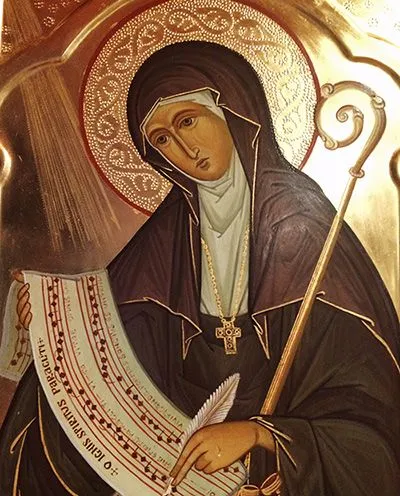Saint Hildegard of Bingen
The Medieval Period
Public domain
There is the music of heaven in all things, and we have forgotten how to hear it until we sing.
Saint Hildegard of Bingen was born in Germany in a small village along the Rhine River in the Holy Roman Empire. As a child, she suffered from poor health and received little education; nevertheless, she became interested in Christian theology and mysticism, and reportedly experienced visions from a young age.
Hildegard entered a Benedictine convent at the age of eight. Another nun, Countess Jutta von Sponheim, taught Hildegard to read and she soon aught herself a variety of subjects, becoming highly accomplished in theology, poetry, science, botany, medicine, and even contructing her own language with its own alphabet and vocabulary. She also studied music and taught herself to play the psaltery. Many of her works survive, including musical compositions. Most of these are similar in style to Gregorian Chants: monophonic modal melodies designed for use in liturgical rites and the daily life of a Benedictine abbey.
Hildegard took her vows at the age of 38 and was soon elected "mother superior" of her community. She clashed with the local bishop, going over his head and getting permission from an archbishop to found her own convent in another city. Despite her lifelong struggles with illness, she lived to the age of 81.

Gerda Arendt, CC0, via Wikimedia Commons
A prolific writer, her views of music were far more elevated than the antiquity period. "When the words come," she wrote, "they are merely empty shells without the music. They live as they are sung, for the words are the body and the music the spirit." In a development of the Pythagorean tradition, she said, "Every element has a sound, an original sound from the order of God; all those sounds unite like the harmony from harps and zithers."
Her Ordo Virtutum is one of the oldest surviving non-liturgical compositions. It is monophonic in texture and features a melismatic contour over a sustained note called a drone. The piece focuses on a female soloist, who represents the human soul. A chorus of female voices represent the virtues (Humility, Chastity, Charity, Faith, Knowledge of God, etc.) who implore the soul to embrace a life of holiness. A male voice represents the Devil, who tries to tempt the soul into a life of sinfulness. The Devil character only speaks or shouts; Saint Hildegard believed a creature so given in to evil would no longer be capable of music. This type of dramatic word painting was several centuries ahead of its time, more characteristic of seventeenth century opera than medieval monophony.
This performance of the Ordo Virtutum also includes a drone produced by a hurdy-gurdy, a medieval hand-cranked mechanical string instrument.
